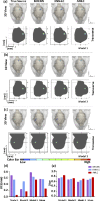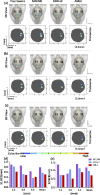Attention mechanism-based locally connected network for accurate and stable reconstruction in Cerenkov luminescence tomography
- PMID: 35003861
- PMCID: PMC8713679
- DOI: 10.1364/BOE.443517
Attention mechanism-based locally connected network for accurate and stable reconstruction in Cerenkov luminescence tomography
Abstract
Cerenkov luminescence tomography (CLT) is a novel and highly sensitive imaging technique, which could obtain the three-dimensional distribution of radioactive probes to achieve accurate tumor detection. However, the simplified radiative transfer equation and ill-conditioned inverse problem cause a reconstruction error. In this study, a novel attention mechanism based locally connected (AMLC) network was proposed to reduce barycenter error and improve morphological restorability. The proposed AMLC network consisted of two main parts: a fully connected sub-network for providing a coarse reconstruction result, and a locally connected sub-network based on an attention matrix for refinement. Both numerical simulations and in vivo experiments were conducted to show the superiority of the AMLC network in accuracy and stability over existing methods (MFCNN, KNN-LC network). This method improved CLT reconstruction performance and promoted the application of machine learning in optical imaging research.
© 2021 Optical Society of America under the terms of the OSA Open Access Publishing Agreement.
Conflict of interest statement
The authors declare no conflicts of interest.
Figures






Similar articles
-
A novel Cerenkov luminescence tomography approach using multilayer fully connected neural network.Phys Med Biol. 2019 Dec 19;64(24):245010. doi: 10.1088/1361-6560/ab5bb4. Phys Med Biol. 2019. PMID: 31770734
-
K-CapsNet: K-Nearest Neighbor Based Convolution Capsule Network for Cerenkov Luminescence Tomography Reconstruction.Annu Int Conf IEEE Eng Med Biol Soc. 2023 Jul;2023:1-4. doi: 10.1109/EMBC40787.2023.10341089. Annu Int Conf IEEE Eng Med Biol Soc. 2023. PMID: 38082846
-
FISTA-NET: Deep Algorithm Unrolling for Cerenkov luminescence tomography.Annu Int Conf IEEE Eng Med Biol Soc. 2023 Jul;2023:1-4. doi: 10.1109/EMBC40787.2023.10340506. Annu Int Conf IEEE Eng Med Biol Soc. 2023. PMID: 38083164
-
Cerenkov luminescence imaging: physics principles and potential applications in biomedical sciences.EJNMMI Phys. 2017 Dec;4(1):14. doi: 10.1186/s40658-017-0181-8. Epub 2017 Mar 11. EJNMMI Phys. 2017. PMID: 28283990 Free PMC article. Review.
-
Cerenkov imaging.Adv Cancer Res. 2014;124:213-34. doi: 10.1016/B978-0-12-411638-2.00006-9. Adv Cancer Res. 2014. PMID: 25287690 Free PMC article. Review.
References
LinkOut - more resources
Full Text Sources
